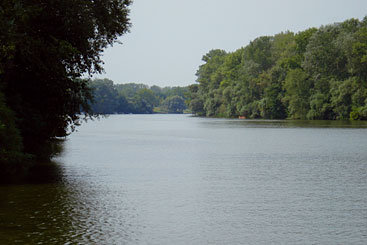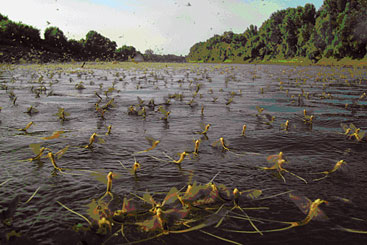
Tisza and Carpathian highlights at Europe’s Environment Conference
On October 11, 2007, the ICPDR coordinated a ‘side event’ geared to recognising and encouraging continued ministerial action in the Tisza River Basin, the largest sub-basin in the Danube River Basin.

The Tisza is the longest tributary of the Danube (966 km)
and drains an area of 157,186 km² in five countries (Slovakia,
Ukraine, Hungary, Romania and Serbia). The states in the
Tisza Basin agreed to cooperate closely, aiming to achieve
integrated management of the Tisza River Basin.
Tisza basin as a european model for ministerial
action. The sixth ministerial conference of the ‘Environment
for Europe’ (EfE) process included the launch of
the ‘Tisza River Basin Analysis 2007: Summary Report
– A call to action’. The report notes the outstanding
diversity of landscapes and species in the Tisza Basin as
well as wetland sites and protected areas. However, “this
region faces serious threats from pollution and river engineering
as well as floods and droughts”, it states.
After an informal get-together at the EfE conference,
a press conference was held at the conference’s Media
Centre. The ICPDR’s Philip Weller presented the
Summary Report and explained its purpose and connection
to the larger ‘Tisza River Basin Analysis’ to be
developed by the end of 2007. He noted that the Summary
Report highlights the need for Tisza countries to
act on specific issues such as pollution and floods, and
that water quality and quantity management should be integrated. “Tisza cooperation is a European
model for ministerial action”, he said.
This was followed by water management
officials from Tisza country governments
(Ukraine, Romania, Slovakia, Hungary
and Serbia) and the European Commission
(EC) publicly voicing their support
for continued cooperation related to Tisza
Basin water protection and management
and implementation of the EU Water
Framework Directive – including support
for the recommendations included in the
Summary Report.
pilot river basins should continue.
“I can assure you that we will provide conditions to finish the Tisza River Basin Management Plan in time and with high quality in Slovakia, and that this will be a pilot plan for other such plans in Europe”, said Mr. Jaroslav Izak, Slovakia’s Minister of the Environment. At the end of the press conference, the speakers made a toast to continued Tisza cooperation and drank from cups imprinted with pictures of Tisza flowers.

Tisza flowers, a type of mayfly, dance on the surface of the Tisza River each spring. The Tisza flower is just one of the treasures found in the Tisza River Basin.
The Tisza Group and Tisza Plan. In 2004, representatives of the five Tisza countries signed a Memorandum of Understanding and agreed to prepare a ‘Tisza River Basin Management Plan’ by the end of 2009. A ‘Tisza Group’ was also created to coordinate all related activities. The first main activity was the development of the ‘Tisza River Basin Analysis 2007’ – with support from the EU – to help decision-makers identify a ‘Programme of Measures’ to be included in the Management Plan.
“The Plan is geared to help the Tisza countries meet the EU Water Framework Directive’s requirements by 2015”, says Joachim D’Eugenio from the EC’s Environment Directorate and Chairman of the Tisza Group. “Europe-wide, the Tisza is probably the most advanced in terms of developing such a Plan at the sub-basin level. This is especially important given the fact that the EU does not require sub-basin level plans, although they are strongly encouraged. Two of the five countries are not even in the EU. Furthermore, the Tisza Plan will go beyond water quality issues to also cover water quantity issues in similar depth, anticipating the future EU Flood Risk Management Directive, EU Water Scarcity Directive and Droughts Action Plan. It is truly a European model and pilot programme for other European sub-basins.”
By the end of 2008, the draft Plan will be available for public consultation. A list of future infrastructure plans and projects will also be compiled and made publicly available.
DEALING THE CARDS IN THE SAVA RIVER BASIN
On October 10, another side event held during the Belgrade conference was the final regional seminar of the EC CARDS regional project ‘Pilot River Basin Plan for Sava River’. The event’s main goal was to present the final results of the project, including successes and difficulties, as well as basic information about the current and upcoming activities of the International Sava River Basin Commission.
The results were presented by the project Team Leader, Senad Ploco from SAFEGE Consulting Engineers. Ploco had coordinated a team of 40 experts who provided more than 3000 man-days to the project, as well as 13 regional and six national workshops. The project’s main goal was to test the EU Common Implementation Strategy for implementing the EU Water Framework Directive (WFD) in river sub-basins, by preparing ‘River Basin Characterisation Reports’ for the pilot Sava River sub-basins of Vrbas (Bosnia and Herzegovina), Kupa (Croatia) and Kolubara (Serbia).
Project achievements included assistance to the Secretariat of the Sava Commission and their active participation in the project, and strengthened regional cooperation (including between the two ‘entities’ in Bosnia and Herzegovina).
Regarding WFD implementation, the project provided a strong push to the Sava Commission and Secretariat to start their WFD-related activities. National experts were also exposed to state-of-the-art European WFD experiences which helped them to develop specific national methodologies and prepare for the process of developing national river basin management plans in accordance with the WFD.
Project outputs included a biological analysis of the Sava Basin (‘Biosurvey’ manual and report), ‘River Basin Characterisation Reports’ for three pilot sub-basins and a ‘Water Quality Chapter’ for the ‘Sava River Basin Analysis Report’.
Project difficulties included a lack of human resources working at public water companies responsible for WFD implementation, and a lack of local experts trained in various WFD-related disciplines (e.g. aquatic ecologists).
Recommendations for further activities included raising
additional assistance for the Sava Commission and Sava
countries to prepare the Sava RBM plan. Water authorities
in all of the Sava countries should initiate closer cooperation
and data exchange with national institutions not directly
belonging to the water sector (e.g. industrial development).
Key decision-makers should be informed as soon as possible
about the capacities needed for successful WFD implementation, and national WFD implementation teams should be
mobilised. Finally, the most serious data gaps noted in the
project should be identified, and preparing the RBM plans for
the pilot river basins should continue.
Pan-European water problems worse in some cases. The sixth ministerial conference of the ‘Environment for Europe (EfE)’ process, held under the auspices of the United Nations Economic Commission for Europe (UNECE), took place in Belgrade, Serbia, from 10 to 12 October. Ministers and high-level officials from 51 UNECE member states and the EC, international organisations, NGOs and other stakeholders discussed progress achieved in the implementation of environmental policies since the Kiev Conference in 2003, capacity building, partnerships and the future of the EfE process.
At the opening session, the key conference report – ‘Europe’s environment – The fourth assessment’ – was presented. The latest in a 15-year series by the European Environment Agency (EEA), the report assesses environmental progress in 53 countries in an area with over 870 million people.
Wide-ranging effects on water across the region are among the report’s highlights. Over 100 million people lack access to safe drinking water and sanitation. In many countries, the quality of water supply and sanitation has deteriorated over the past 15 years. There is particular concern also about eutrophication, coastal environments and climate change impacts.
“Our report shows that there has been progress”, said EEA Executive Director Jacqueline McGlade. “We have reduced some air pollution and improved wastewater treatment. However, in an era of change, major concerns remain such as climate, biodiversity and environment-related health threats. To respond to these complex environmental issues, we need continued cooperation across the pan-European region as well as targeted financial and technical support.” She added that further assessment, communication and education to help overcome the “information gap” were required to “better equip those who need to act”.

Water management
officials from Tisza
country governments
(Ukraine, Romania,
Slovakia, Hungary and
Serbia) and the European
Commission publicly
voiced their support for
continued cooperation
related to Tisza Basin
water protection and
the speakers made a
toast to continued Tisza
cooperation with
mugs imprinted with
Tisza flowers.
Carpathians environmental outlook 2007. Among the many side events held during the EfE conference, the ‘Carpathians Environmental Outlook 2007’ was launched and presented by the United Nations Environment Programme (UNEP). As the Carpathian region covers an extensive area of the Danube River Basin shared by six Danube countries, its results and recommendations are highly valuable for Danube decisionmakers, especially to complement the ‘Tisza River Basin Analysis 2007’ now in progress.
The report is divided into five main chapters including a (1) Background and Introduction, (2) Socio-Economic Driving Forces, (3) State of the Carpathians’ Environment and Policy Measures (with a sub-chapter called ‘Water Resources’), (4) Outlook 2005 to 2020: Three Scenarios for the Carpathian Region’s Future Development and (5) Conclusions and Options for Action. It was prepared in its entirety by scientific and governmental experts from the Carpathian countries.
“The report is a source of knowledge that can evolve to support the new and developing needs of the Carpathian countries and relevant organizations in their quest to deliver common and concrete solutions to the challenges and opportunities now and in the years to come”, says UNEP Executive Director Achim Steiner.
Disclaimer
The information contained in the ICPDR website is intended to enhance public access to information about the ICPDR and the Danube River. The information is correct to the best of the knowledge of the ICPDR Secretariat. If errors are brought to our attention we will try to correct them.
The ICPDR, expert group members, nor other parties involved in preparation of information contained on this website cannot, however, be held responsible for the correctness and validity of the data and information provided, nor accept responsibility or liability for damages or losses arising directly or indirectly from the use of the information conveyed therein.
Only those documents clearly marked ICPDR documents reflect the position of the ICPDR.
Any links to other websites are provided for your convenience only. The ICPDR does not accept any responsibility for the accuracy, availability, or appropriateness to the user's purposes, of any information or services on any other website.
When using the information and material provided on this website, credit should be given to the ICPDR.
